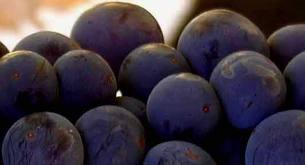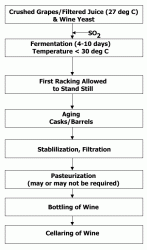Chemical and Process Engineering Resources

What is Wine?
There are red wines, pink wines (also known as "rose" or some-times "blush") and white wines. Red wine result when the crushed grape skin pulp and seeds of purple or red varieties are allowed to remain with juice during fermentation periods. Pink / rose wine can be produced by removing the non-juice pumace from the must during fermentation. White wines can be made from pigmented grapes by removal of skins, pulp and seeds before juice fermentation. Wines might be "fortified," "sparkling," or "table."How is Wine Made?
Growing Grapes
Grapes grow on vines. There are many different types of grapes, but the best wine grape is the European Vitis vinifera. It is considered optimal because it has the right balance of sugar and acid to create a good fermented wine without the addition of sugar or water.Harvest
Weather is a major factor is determining whether a year is going to be a "good vintage" (or "year"). For example, was there enough heat during the growing season to lead to enough sugar? At harvest time, the short-term effects of weather are quite important. To produce great wine, the fruit should have a high (but not overly high) sugar content ("brix"). Think of raisins. As the fruit dries, the water evaporates. What is left is the sugary fruit. If it rains just at the point the wine grapes are ready, and before the grapes can be harvested, the additional water will cause the water level to increase, and the brix will go down. Not good. (You might ask, why not just add some sugar in the wine making process? Some do. Also considered "not good.") Every year the wine grape grower plays a game of chance and must decide when to harvest. Simplistically, if you knew it wasn't going to rain, you would just test the brix until it was just right, then harvest. If you harvest too soon, you will probably end up getting a wine too low in alcohol content (there won't have been enough sugar to convert to alcohol). These wines will be "thin." If you delay harvest, there may be too much sugar, which leads to too low acid content. This also affects the taste (and the aging possibilities) of the wine.Initial Processing of the Grape Juice
Grapes can (and might still) be crushed by stomping on them with your feet in a big vat. But a more practical way is to use a machine which does the job (and at the same time, removes the stems). What you get may or may not get immediately separated. Skin and seeds might immediately be removed from the juice. Separation may not immediately occur (especially for red wines), since skins and stems are an important source of "tannins" which affect wine's taste and maturity through aging. (See Aging Wines.) The skins also determine the color of the wine (see WHAT IS WINE). Maceration (the time spent while skins and seeds are left with the juice) will go on for a few hours or a few weeks. Pressing will then occur. One way to press the grapes is to use a "bladder press," a large cylindrical container that contains bags that are inflated and deflated several times, each time gently squeezing the grapes until all the juice has run free, leaving behind the rest of the grapes. You can also separate solids from juice through the use of a centrifuge.Operations in a Winery

Â
Fermentation - Turning Grape Juice into Alcohol
Grape juice is turned into alcohol by the process of "fermentation."Â Grapes on the vine are covered with yeast, mold and bacteria. By putting grape juice into a container at the right temperature,yeast ( SACCHROMYCES ELLIPSOIDUES )Â will turn the sugar in the juice into alcohol and carbon dioxide. The grape juice will have fermented. Fermentation is carried out in stainless steel vessels.
Yeast also gives flavor to the wine. But the yeast that is on the grape skin when it is harvested may not have the desired flavor. Other things on the outside of a grape are not good for wine (for example, acetic bacteria on the grapes can cause the wine to turn to vinegar). The winemaker can eliminate unwanted yeast's, molds and bacteria, most commonly by using the "universal disinfectant," sulfur dioxide. Unfortunately, the sulfites which remain in the wine may cause a lot of discomfort to some wine drinkers. (See ALLERGIC REACTIONS TO WINE.). Some winemakers prefer NOT to do this, and purposely create wines that are subject to the vagaries (and different flavors) of the yeast that pre-exist on the grapes ("wild yeast fermentation").
The winemaker has many different yeast strains to choose from (and can use different strains at different times during the process for better control fermentation ). The most common wine yeast is Saccharomyces.
This is a good point to stop and mention "Brett," also known as the Brettanomyces strain of yeast (which can be added or come from wild yeast fermentation). As yeast works, it causes grape juice ("must") to get hot. But if there's too much heat, the yeast won't work. Cooling coils are necessary to maintain a temperature below 30° C.
A less modern, but still wide widely used way to ferment wine is to place it in small oak barrels. "Barrel fermentation" is usually done at a lower temperature in temperature controlled rooms and takes longer, perhaps around 6 weeks. The longer fermentation and use of wood contributes to the flavor (and usually expense) of the wine.
The skins and pulp which remain in a red wine vat will rise to and float on top of the juice. This causes problems (if it dries out, it's a perfect breeding ground for injurious bacteria), so the winemaker will push this "cap" back down into the juice, usually at least twice a day. In large vats, this is accomplished by pumping juice from the bottom of the vat over the top of the cap.
Â
Eventually the yeast is no longer changing sugar to alcohol (though different strains of yeast, which can survive in higher and higher levels of alcohol, can take over and contribute their own flavor to the wine-as well as converting a bit more sugar to alcohol). Â After all this is completed what you have left is the wine, "dead" yeast cells, known as "lees and various other substances.
Â
Malo-Lactic Fermentation
The winemaker may choose to allow a white wine to undergo a second fermentation which occurs due to malic acid in the grape juice. When malic acid is allowed to break down into carbon dioxide and lactic acid (thanks to bacteria in the wine), it is known as "malo-lactic fermentation," which imparts additional flavor to the wine. A "buttery" flavor in some whites is due to this process. This process is used for sparkling wines.
Â
First Racking
After fermentation completed naturally or stopped by addition of distilled spirit, first racking is carried out. This involves the wine to stand still until most yeast cells and fine suspended material settle out. The wine is then filtered without disturbing the sediment or the yeast.
Â
Winery Aging
The winery may then keep the wine so that there can be additional clarification and, in some wines, to give it a more complex flavors. Flavor can come from wood (or more correctly from the chemicals that make up the wood and are taken up into the wine).  The wine may be barrel aged for several months to several years. No air is allowed to enter the barrels during this period.
Ignoring any additional processing that might be used, you could empty the barrels into bottles and sell your wine. However, during the winery aging, the smaller containers may develop differences. So the winemaker will probably "blend" wine from different barrels, to achieve a uniform result. Also, the winemaker may blend together different grape varieties to achieve desired characteristics.
Â
Stabilization and Filtration
Stabilization is carried out to remove traces of tartaric acid. These tartarates present in the grape juice tend to crystallize in wine and if not removed completely can slowly reappear as glass like crystals in final bottles on storage. Â Stabilization with respect to tartarates may involve chilling of wine that can crystallize tartarates and these crystals can be removed by filtration.
Â
Pasteurization
If the wine has an alcohol content less than 14% it may be heat pasteurized or cold pasteurized through microporous filters just before bottling.
Â
Bottling Wine
Producers often use different shaped bottles to denote different types of wine. Colored bottles help to reduce damage by light. (Light assists in oxidation and breakdown of the wine into chemicals, such as mercaptan, which are undesirable.)  Bottle sizes can also vary.
Â
Cellaring Wine
Most people assume that the longer that you keep a wine, the better it will get Since its best to store wine under certain conditions, like in a cool damp underground cellar, this is known as "cellaring" wine.  It is a misconception that you MUST age wine. The fact is, throughout the world, most wine is drunk "young" (that is relatively soon after it is produced, perhaps 12 to 18 months), even wines that are "better" if aged. While some wines will "mature" and become better over time, others will not and should be drunk immediately, or within a few years.
Tannin is a substance that comes from the seeds, stems and skins of grapes. Additional tannin can come from the wood during barrel aging in the winery. It is a preservative and is important to the long term maturing of wine. Through time, tannin (which has a bitter flavor) will precipitate out of the wine (becoming sediment in the bottle) and the complexity of the wine's flavor from fruit, acid and all the myriad other substances that make up the wine's character will come into greater balance. Generally, it is red wines that are the ones that CAN (but do not have to be) produced with a fair amount of tannin with an eye towards long term storing and maturation. The bad news is that you shouldn't drink it young since it will taste too harsh (and probably cost too much, besides). The good news is that after a number of years, what you get is a prized, complex and balanced wine.
Remember that red wines get their color from the stems and skins of the grape. This gives the wine tannin and aging capacity. White wines may have no contact with the stems and skins and will have little tannin (though some can be added, again, through barrel aging). Therefore most white wines don't age well. Even the ones which do get better through time will not last nearly as long as their red cousins. A fair average for many "ageable" whites would be about 5 to 7 years (some might go 10). On the other hand, really "ageable" reds can easily be kept for 30 years and longer.
Â
Storing Wine
For wines that should be aged, a cellar should have proper :Temperature which does not have rapid fluctuation. 55 degrees Fahrenheit is a good, but you can live with 50 to 57 degrees Fahrenheit (10 to 14 degrees Centigrade). Wide swings in temperature will harm the wine. Having too high a temperature will age the wine faster so it won't get as complex as it might have. Having too low a temperature will slow the wine's maturation.Humidity. About 60 percent is right. This helps keep the cork moist. The wine will oxidize if the air (and its oxygen) gets to it. If the cork dries out, it can shrink and let air in. This is another reason to keep the bottles on their sides. The wine itself will help keep the cork moist.
Lack of light.
Lack of vibration.
Lack of strong odors. Whatever it is that is causing the odor stands a good chance of getting through the cork and into the wine.
References
- CHEMICAL PROCESS INDUSTRIES – R. Norris Shreve, Joseph A. Brink, IV Edition
- INTERNET.- www.op.net/cgi-bin/doctxt/FAQs/wine

 FB
FB

0 Comments